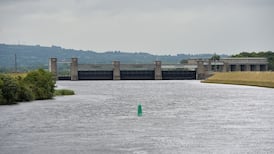The pattern of exceptionally dry weather has continued into May, with more sunshine compared to April contributing to drier land and impacting on groundwater volumes.
Parts of the country reported the driest April in more than 40 years with mild and settled weather across most of the State, according to Met Éireann. The ground needs at least 50mm of rain to restore moisture levels to normal.
A “blocking” anticyclone from the south brought fine, settled and dry weather for the start of May in contrast to the normal pattern of rain fronts from the west at this time of year.
Since the start of the month, many areas have had little or no rain, with 10 per cent of normal rainfall levels for this time of year in some places.
Rainfall across the State was some 25 per cent of normal last month. Mullingar reported its driest April since the station opened in 1950 with just 14.1mm of rain. The majority of stations across the State reported their driest conditions for between nine and 44 years.
Climate change
April was dull while May has been sunny, which accounts for increased risk from gorse fires. The winter period has been very dry with rainfall at 60 to 90 per cent of normal, depending on location. The one blip has been March when weather stations recorded some of the wettest weather for March since records began.
The “soil moisture deficit” is currently at between 30 and 45 mm, which reflects the dry conditions and is “quite high for this time of the year”, according to Aidan Murphy who handles climate inquiries at Met Éireann.
The current weather pattern, however, cannot be linked to climate change, he added. While climate change is predicted to give us drier summers and more extreme weather episodes, the recent dry period falls within the natural variability of climate.
Irish Water, which has responsibility for public water supplies, confirmed there was no immediate requirement for restrictions in major urban areas in spite of exceptionally low rainfall.
"Overall, the current supply situation is sustainable but Irish Water and the local authorities are continuing to monitor and manage the situation on a daily basis," a spokesperson said.
There have been localised appeals to conserve water in parts of north Galway, Donegal and Westmeath but local raw water sources are the issue.
Likewise, the Aran Islands have been asked to conserve water but this is standard there for this time of year due to the lack of groundwater sources and topography.
Scenario
Parts of Connemara have been exceptionally dry of late, reflecting a scenario where temperatures have been higher along the western half of the country in recent weeks.
Any periods of prolonged dry weather can potentially impact on the volumes of raw water available for treatment, Irish Water said.
Raw water is the untreated water which comes from lakes, rivers and boreholes. This is treated at Irish Water’s plants and then allowed into distribution networks to serve consumers.
Treatment plant staff are monitoring the raw water levels at each source, a spokesperson confirmed. If levels at a source are dropping and there is a concern about the ability of that plant to provide sufficient treated water, Irish Water and the relevant local authority look into options for the at-risk supply.
The Greater Dublin region, for example, is supplied by five major water treatment plants and some groundwater sources and network adjustments can be made to reduce the dependency on the affected areas.
Production can be increased in non-affected areas where capacity allows to safeguard storage levels in the affected reservoirs. Irish Water, being a national utility, has added benefits such as central monitoring and planning.
In addition, there has been ongoing leak detection and repair, which has held leakage rates steady, indicating a natural demand increase due to increasing population and commercial activities.
The dry spell is forecast to end with rain developing across the country over the weekend and next week but just some scattered showers are likely for Thursday and Friday, according to Met Éireann.
After a wetter period towards the middle of the month, dry conditions may return towards the end of May.











